Occupational environment monitoring of a pen manufacturing factory
99,000 ₫
Note: The above price is calculated for one sample, and the price may fluctuate depending on the area of the environment to be monitored and market movements. For more accurate pricing support, please refer to the price list or contact our consulting staff directly.
Monitoring the environment of a pen manufacturing factory is a session of collecting, analyzing, and evaluating factors at the workplace that may harm workers health.
Table of Contents
Toggle1. Overview of Pen Manufacturing Factories
a. What is a pen manufacturing factory?
A factory that manufactures pens is a production facility specialized in producing various types of writing instruments. This factory typically has dedicated equipment and production lines to produce different types of pens, including ballpoint pens, fountain pens, gel pens, ink pens, and many other types of writing instruments.
Pen manufacturing factories may employ different technologies and production processes depending on the type of pen and the scale of production.

b. Production stages in a pen manufacturing factory
The main stages in the pen production process at a factory may include:
- Material preparation: The factory collects necessary materials such as plastic, metal, ink, ink cartridges, pen tips, caps, and other additives.
- Mold preparation: If the pen has a plastic body, molds are prepared to shape and size the pen body. Molds are typically made of steel or aluminum and are designed to match the specific type of pen.
- Molding: The molding process uses specialized molding machines to inject plastic material into molds to form pen components such as the body, cap, and other small parts. Once molded, the components are removed from the molds.
- Preparation of other parts: Other pen components such as pen tips, ink cartridges, and mechanical parts are manufactured or sourced from suppliers. These parts may be pre-assembled or prepared for the next assembly stage.
- Assembly: Pen components are assembled manually or using automated machines. The pen tip is attached to the body, the ink cartridge is inserted, and mechanical parts like the cap and push mechanism are connected.
- Quality inspection: Assembled pens undergo quality checks. This may include writing tests, durability tests, feature checks such as ink flow sensitivity (for ink pens) or smoothness (for gel pens), and other quality standards.
- Packing: After passing quality inspection, pens are packed into individual sets or larger packaging units.

c. Machinery used in pen manufacturing factories
In a pen manufacturing factory, various machines are used to increase efficiency and ensure high-quality products. Common machines used in the pen production process include:
- Molding machines: Used to mold pen components from plastic, creating parts such as the body, cap, ink tube, and small parts.
- CNC machining machines: CNC (Computer Numerical Control) machines are used to process metal pen parts like tips, caps, and mechanical components. These machines operate under computer control for precise and automated manufacturing.
- Automatic assembly machines: Automated assembly machines attach pen tips to bodies, insert ink tubes, attach caps, and assemble mechanical parts.
- Quality inspection machines: These machines check writing performance, durability, smoothness, ink sensitivity, and other features. They can automatically evaluate product quality.
- Packing machines: Used to pack pens into individual boxes, plastic bags, or other packaging after production.
- Printing machines: Used to print logos, brand names, or other information on pen surfaces using techniques such as thermal printing, laser printing, or direct printing.
These machines improve productivity, ensure consistent quality, and optimize the production process in a pen manufacturing factory.

d. Occupational diseases that may occur for workers in pen manufacturing factories
Workers in pen manufacturing factories may be exposed to certain occupational diseases. Common examples include:
- Respiratory diseases: Exposure to chemicals during pen production, such as ink fumes, solvents, and fine dust, may cause respiratory issues including airway inflammation, coughing, and breathing difficulties.
- Skin diseases: Prolonged contact with chemicals can cause skin irritation, dermatitis, eczema, and other allergic reactions. Cleaning agents, solvents, and antioxidants used in production can damage the skin.
- Hand and neck disorders: Repetitive assembly and packing movements like gripping, twisting, and pressing can cause musculoskeletal problems, such as joint inflammation, wrist disorders, and repetitive strain injuries.
- Vision problems: Working in low or flickering light and focusing for long periods on detailed tasks like assembly and inspection can cause eye strain and other vision-related issues.
- Hearing problems: Noise from machinery can lead to hearing damage, hearing loss, and other ear-related issues.

e. Types of products in a pen manufacturing factory
A pen manufacturing factory produces a wide variety of products, including:
- Ballpoint pens: Widely used in offices and schools, they use a small ball to transfer ink onto paper.
- Ink pens: Contain ink stored in a cartridge or tube, used for writing by moving the pen tip up and down.
- Fountain pens: Use special liquid ink, with nibs or brushes for writing on paper.
- Gel pens: Use gel-based ink instead of liquid ink, providing smooth writing and vibrant colors. The tip may be metal or plastic.
- Wax crayons: Mainly used for drawing and coloring, with a wax tip for creating lines and shading on paper.
- Whiteboard markers: Used on whiteboards or similar surfaces; the ink can be easily wiped off with a damp or dry cloth.
- Refillable pens: Pens that can be refilled with ink for repeated use without replacing the tip or cartridge.

2. Overview of Occupational Environment Monitoring Services
a. What is occupational environment monitoring at a pen manufacturing factory?
Occupational environment monitoring (or workplace environmental measurement) at a pen manufacturing factory is the process of collecting, evaluating, and analyzing measurements of workplace environmental factors. This aims to implement timely measures to minimize environmental impacts on worker health and prevent occupational diseases. Monitoring is a mandatory requirement for pen manufacturing factories.
Occupational environment monitoring is crucial for protecting, maintaining, and enhancing workers’ health, as employees are the main resource directly generating profits for the company. Continuous exposure to risk factors exceeding allowable standards can harm health and cause occupational diseases.
REGISTER FOR OCCUPATIONAL ENVIRONMENT MONITORING SERVICE
b. Nam Viet’s occupational environment monitoring program
Nam Viet’s occupational environment monitoring program is developed by monitoring engineers specializing in occupational safety and environmental protection. To ensure worker health and safety, this program uses modern measurement methods to monitor air quality, water, microclimate factors, physical factors, dust, and more in the workplace. This program is essential for ensuring a safe working environment and protecting workers’ health.
Additionally, Nam Viet’s program plays a key role in researching and developing new solutions to improve workplace environmental quality. With the dedication and professionalism of its monitoring experts, Nam Viet’s exclusive program is a breakthrough in occupational safety and environmental management in Vietnam.

c. Standardization in workplace environmental measurement processes
Standardization in Nam Viet’s workplace environmental measurement processes is critical for ensuring the accuracy and reliability of results. The program follows recognized standards and procedures set by the Ho Chi Minh City Department of Health. This ensures collected data are reliable for evaluating workplace environments and making decisions to improve occupational safety and protect worker health.
These standardized procedures ensure that measurements are performed by highly qualified monitoring experts with years of experience, giving managers and specialists confidence in Nam Viet’s results for making accurate and valuable decisions in occupational health and environmental protection.
By applying standardization in environmental measurements, Nam Viet demonstrates its commitment to providing a safe working environment, protecting worker health, and contributing positively to the development and enhancement of occupational safety and environmental management in Vietnam.
d. Reporting results of pen factory environmental monitoring
Monitoring results are prepared according to Form No. 04, Appendix III issued with Decree 44/2016/ND-CP and prepared in two copies: one sent to the contracting workplace and one kept by the monitoring organization.
The retention period for environmental monitoring records is indefinite according to legal regulations.

e. Frequency of occupational environment monitoring according to the law
According to Clause 2 of Article 18 of the Law on Occupational Safety and Hygiene 84/2015/QH13, employers must organize occupational environment monitoring at least once a year to evaluate harmful factors.
f. Deadline for submitting occupational environment monitoring reports according to the law
The deadline for report submission is before December 31 each year. Enterprises in production facilities must submit monitoring results to the local Department of Health where their head office and employees are located.
Whenever there are changes in technology, production processes, or when renovating/upgrading facilities that may introduce new hazardous factors affecting worker health, enterprises must update their occupational health records regarding harmful factors requiring monitoring.
g. Penalties for violations of occupational environment monitoring by employers
According to Article 27 of Decree No. 12/2022/ND-CP dated January 17, 2022, regulating administrative penalties in labor, social insurance, and Vietnamese workers working abroad under contract:
- Clause 2: Fines from 2,000,000 – 5,000,000 VND for employers who fail to publicly inform employees at the monitored workplace or at sites being evaluated about monitoring results and hazard management immediately after the monitoring results are available.
- Clause 3: Fines from 20,000,000 – 40,000,000 VND for employers who do not conduct occupational environment monitoring to control hazards affecting worker health according to the law.
- Clause 4: Fines from 40,000,000 – 60,000,000 VND for employers who collaborate with monitoring organizations to commit fraud in occupational environment monitoring activities without reaching criminal liability.
3. Harmful Environmental Factors for Workers in Pen Manufacturing Factories
In a pen manufacturing factory, workers may be exposed to several harmful environmental factors. Below are some examples of environmental factors that may be harmful to workers:
- Chemicals: The pen production process may involve chemicals such as solvents, cleaning agents, antioxidants, and ink. Prolonged exposure to these substances can cause skin irritation, respiratory inflammation, vision problems, and potential effects on the nervous system.
- Dust and fumes: During pen production, dust may arise from metal processing, mold casting, cutting, grinding, or plastic materials. Dust and fumes can damage the respiratory system and cause pneumonia, as well as irritate the eyes and skin.
- Noise: Machinery and equipment in pen manufacturing factories can generate high noise levels. Continuous or high-intensity noise can harm hearing, cause ear fatigue, risk of deafness, and affect overall health.
- Lighting: Activities in pen factories often require good lighting for detailed work. However, strong light, glare, or flickering light can cause eye strain, visual fatigue, and affect vision.
- Temperature and humidity conditions: Some pen production processes may require specific temperature and humidity conditions. Working environments that are too hot, too cold, too dry, or too humid can affect health, cause discomfort, and reduce concentration.
REGISTER FOR WORKPLACE ENVIRONMENT MONITORING SERVICE
4. Measures to Improve Working Conditions in Pen Manufacturing Factories
To improve working conditions in pen manufacturing factories and ensure workers’ health, the following measures can be applied:
- Ensure ventilation and chemical management: Ensure good ventilation systems to clean the air and remove harmful chemicals. Provide exhaust systems, ventilation fans, and respiratory protection equipment to reduce exposure to hazardous chemicals.
- Provide personal protective equipment (PPE): Ensure proper provision and use of PPE such as safety goggles, respirators, gloves, protective clothing, and noise-canceling headphones. PPE protects workers from harmful environmental factors and reduces the risk of occupational diseases.
- Training and education: Ensure workers are trained in occupational safety, can identify harmful environmental factors, and know how to use PPE. Additionally, strengthen education on safety regulations, safe work procedures, and accident and occupational disease prevention measures.
- Noise control: Apply technical measures to reduce noise, such as using soundproofing materials, insulation, and sound barriers, as well as maintaining and isolating noisy machinery and equipment. Additionally, provide noise-canceling headphones and ensure compliance with noise regulations in the workplace.
- Lighting management: Provide adequate natural and artificial lighting in pen factories. Ensure sufficient illumination for detailed work and use shades or curtains to adjust strong or glaring light.
- Periodically conduct workplace environment monitoring in factories, collect and analyze harmful factors for workers, and adjust measures to reduce hazards and prevent occupational diseases.
5. Benefits of Periodic Monitoring in Pen Manufacturing Factories
An Toan Nam Viet provides excellent benefits to enterprises using workplace environment monitoring services in accordance with Decree 44/2016/ND-CP on the management and control of harmful factors in working environments affecting workers.
- Enterprises can proactively control harmful factors in their workshops or factories.
- Receive recommendations for measures to reduce harmful factors and improve the quality of the working environment.
- Indirectly protect human resources, the main factor in enterprise development.
- Minimize the impact of occupational diseases on workers’ health, thereby reducing future treatment costs.
- Improved worker health leads to higher product quality and ensures production output.
- Comply with labor safety regulations and avoid legal risks.
- Enhance professionalism and reputation, thereby elevating the enterprise’s brand.
Nam Viet’s environmental monitoring service is a solution to reduce occupational disease risks, contributing to a clean and high-quality working environment.

6. Nationwide Workplace Environment Monitoring Center
Nam Viet Workplace Environment Monitoring Center is a professional unit specializing in monitoring and measuring workplace environmental quality throughout all provinces of Vietnam. With an experienced team of monitoring specialists, the center uses modern measuring equipment to ensure accuracy and reliability.
In addition to monitoring services, the center assists clients in planning, handling, and tracking workplace environmental issues. Following the motto “customer-centric,” the center prioritizes client satisfaction, meets all needs, and provides the best solutions for businesses.
REGISTER FOR WORKPLACE ENVIRONMENT MONITORING SERVICE
With investment in technology, equipment, and personnel, Nam Viet’s monitoring center has become a reputable unit in the field of workplace environment monitoring in Ho Chi Minh City, with goals including:
- We always prioritize brand reputation and service quality.
- We provide clients with the best and most suitable solutions.
- Alongside a team of experienced Masters and Engineers aiming to protect the environment and benefit businesses.
- By working with Nam Viet Environmental Monitoring, companies receive professional service from experts in the field, along with the best cost advantages.
The workplace environment monitoring process at Nam Viet includes:
- Before monitoring, all machinery and equipment are calibrated according to legal regulations.
- Implement the full monitoring process as committed to the Department of Health.
- Report monitoring results honestly to employers.
- If monitoring results indicate unsafe conditions, Nam Viet will provide solutions, and the enterprise will implement the following:
- Implement measures to improve working conditions, minimize harmful factor impacts, and prevent occupational diseases.
- Organize health check-ups to detect occupational and work-related diseases early for employees in unsafe environments.
- Provide in-kind benefits to employees according to labor laws.

7. Workplace Environment Monitoring Service Price List
To help businesses perform workplace environment monitoring professionally and effectively, Nam Viet provides clients with a quality and reasonably priced service price list.
- Our price list provides detailed information on the costs of the monitoring services we offer, including transportation, measurement, analysis, and reporting. Clients can trust the accuracy and reliability of our reports.
- We commit to providing the most competitive and reasonable prices in the market and are always ready to answer questions about monitoring services quickly and professionally.
- With Nam Viet’s price list, clients can easily choose service packages that meet their needs. We are committed to delivering the highest satisfaction with professional service quality.
No comments yet

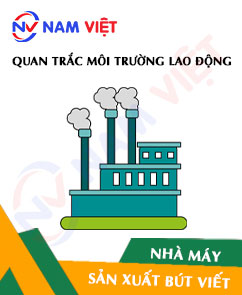
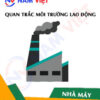
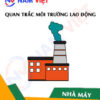




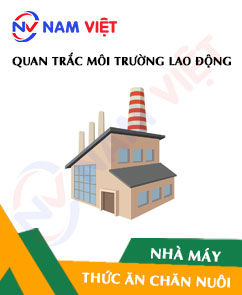
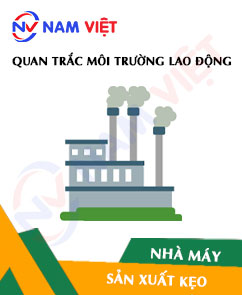

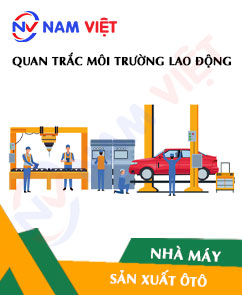
Review Occupational environment monitoring of a pen manufacturing factory
There are no reviews yet.